
With the much-anticipated total solar eclipse set to pass over Texas on April 8, preparations are underway for an influx of travelers, estimated between 931,000 and 3,725,000, all eager to witness this astronomical phenomenon within the United States.
These projections come from GreatAmericanEclipse.com, a reputable source for celestial events.
Cities Bracing for a Surge in Visitors
Notably, according to eclipse cartographer Michael Zeiler, certain cities are gearing up for a substantial increase in visitors.
Kerrville, Texas; Carbondale, Illinois; Franklin, Indiana; and Erie, Pennsylvania, are among the areas expecting up to 200,000 visitors each. Kerrville and Franklin could potentially surpass 400,000 visitors.
Zeiler, renowned for his expertise in eclipse cartography, emphasizes the impact on metropolises within 100 miles of the eclipse path, warning of significant traffic congestion on the day of the event.
Texas: The Epicenter of Eclipse Tourism
Texas is emerging as the focal point for eclipse tourism, with over a million people anticipated to travel to witness the celestial spectacle.
More than 12 million individuals reside within the eclipse path, indicating the potential for a considerable surge in visitors.
Zeiler’s eclipse maps predict that specific Texas cities might witness an influx of nearly 500,000 visitors on April 8 during the total solar eclipse, highlighting the magnitude of this celestial event.
Understanding Eclipse Tourism Predictions
Michael Zeiler, drawing on his extensive background in geography and a personal passion for eclipse-chasing, began crafting eclipse maps in 2009.
His predictions are based on fundamental assumptions, primarily considering that individuals tend to travel the shortest distance to reach the path of totality, where the sun is entirely obscured.
Zeiler’s second assumption involves proximity, as individuals living closer to the eclipse path are more likely to travel for this unique experience.
By tracing the shortest paths from various locations, Zeiler accurately forecasts the likely destinations of eclipse enthusiasts.
Impact on Transportation and Recommended Viewing
These predictions align with warnings from experts over the past year, including the Texas Department of Transportation, which anticipates up to a 200% increase in traffic in some rural regions during the eclipse.
In response, some seasoned eclipse chasers opt for less congested areas, such as the open sea, for a more relaxed viewing experience.
For those in Austin, Zeiler suggests heading to the northwest part of the city to maximize the duration of totality. While many may choose to stay in Austin, those seeking an extended eclipse experience might travel 40 to 50 miles to the west or north.
Zeiler’s estimates, comprehensive as they are, do not account for residents within the path of totality who plan to travel, potentially resulting in an even greater influx of people on the roads.
ESTA: Streamlining Travel Authorization
As the nation gears up for this celestial event, international travelers must know about the Electronic System for Travel Authorization (ESTA).
ESTA is a convenient online system administered by the U.S. government, designed for citizens of Visa Waiver Program (VWP) countries.
For up to 90 days, they can travel to the United States without a visa for tourism or business.
ESTA ensures a smooth entry process for eligible travelers, offering a streamlined and efficient authorization system.
It is particularly beneficial for those planning to witness events like the upcoming eclipse, facilitating hassle-free travel to the United States.
As the nation anticipates the mesmerizing solar eclipse, travelers should prepare for the celestial spectacle and ensure they comply with the necessary travel authorizations, such as ESTA, to make their journey to the United States seamless and enjoyable.

